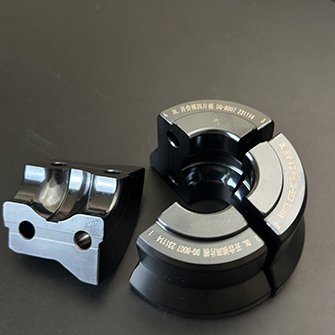Three-Piece Collapsible Molds play a vital role in industries such as injection molding, packaging, and automotive manufacturing, where precision and flexibility are paramount. These molds, which consist of three separate pieces that collapse to allow easy removal of parts, are known for their ability to produce complex shapes with ease. However, the fabrication of three-piece molds presents several challenges, including dimensional precision, material durability, and the complexity of mold design. This article will explore these challenges and the strategies used to overcome them, ensuring the longevity and efficiency of the molding process.

1. Dimensional Precision
One of the most critical challenges in three-piece Collapsible Mold fabrication is achieving the necessary dimensional precision. Molds are designed to create parts with tight tolerances, and any deviation in mold dimensions can lead to defects in the final product, which may require costly rework.
Challenges:
Tolerances: Tight tolerances are often required, especially when producing parts with complex geometries or intricate features.
Shrinkage and Warping: Materials used in mold fabrication, such as metals and composites, can shrink or warp during the cooling process, causing inaccuracies in mold dimensions.
Tooling Wear: Over time, wear and tear on the mold components, especially on high-usage surfaces, can result in dimensional drift.
Strategies to Overcome:
Precision Machining: Using advanced CNC machines ensures high accuracy during the fabrication process. These machines can cut and shape mold components to the tight tolerances required.
Computer-Aided Design (CAD) & Simulation: CAD software allows for detailed modeling of the mold, simulating how the mold will behave during the molding process. Simulation software can predict how materials will shrink or expand during cooling, helping to adjust the design for more accurate results.
Inspection and Measurement: Implementing stringent quality control measures, such as using coordinate measuring machines (CMM) or laser scanning, ensures that the mold meets all dimensional specifications before production begins.
2. Material Durability
The longevity and performance of a Three-Piece Collapsible Mold heavily depend on the materials used in its fabrication. The mold must withstand the harsh conditions of high pressure, temperature fluctuations, and repeated use over time.
Challenges:
Wear and Tear: High-stress applications can lead to rapid wear, especially in areas that undergo constant friction or pressure, such as the parting lines or core.
Heat Resistance: Mold components must endure high temperatures during the molding process, which can cause material degradation if the wrong materials are chosen.
Corrosion: If the mold is exposed to moisture or aggressive chemicals, corrosion can weaken the mold, resulting in costly repairs and replacements.
Strategies to Overcome:
Material Selection: Choosing durable, heat-resistant materials, such as hardened tool steels, alloy steels, and high-performance composites, is critical for ensuring the mold’s longevity. Materials with high wear resistance, like carbide-coated components, can be used in high-wear areas.
Surface Coatings: Applying specialized coatings, such as chrome plating or nitriding, enhances the mold's resistance to wear, corrosion, and heat. These coatings provide an extra layer of protection and can extend the mold’s service life.
Regular Maintenance and Lubrication: Periodic cleaning and lubrication of mold components help to reduce friction and minimize wear. Scheduled maintenance and inspections can also identify early signs of damage, preventing further degradation.
3. Complex Mold Design and Functionality
The complexity of a three-piece collapsible mold often poses significant design and functionality challenges. Achieving a mold that collapses smoothly to release the part, while ensuring that all components fit together seamlessly, requires intricate design work and careful alignment.
Challenges:
Component Alignment: Achieving precise alignment between the core, cavity, and insert parts is critical to ensure the smooth operation of the collapsible mechanism.
Undercuts and Geometric Complexity: Many molded parts feature undercuts or intricate geometric features that are difficult to replicate using traditional molding techniques, requiring precise engineering and a reliable mold design.
Ejection Mechanism: Designing an effective ejection mechanism is vital to ensure that parts are easily removed from the mold without damaging the molded product.
Strategies to Overcome:
Advanced Design Software: The use of CAD and CAE (Computer-Aided Engineering) software allows for the development of detailed mold designs, including intricate features like undercuts and complex geometries. These tools also help to visualize the mold collapse and ensure the correct alignment of components.
Modular Design: Incorporating modular design elements allows for easier customization and fine-tuning of the mold components. Interchangeable parts, such as inserts and pins, can be used to adapt the mold to different shapes or sizes.
Prototype Testing: Before the final mold is fabricated, prototyping with 3D printing or rapid prototyping techniques can help test the design and identify any potential issues with alignment, ejection, or mold collapse.
4. Mold Cycle Time and Production Efficiency
While achieving precision and durability is important, minimizing mold cycle time is essential for ensuring cost-effective production. A mold that requires extensive cooling times or frequent maintenance can significantly slow down the manufacturing process.
Challenges:
Cooling Efficiency: The cooling rate of the mold affects how quickly it can be reused in the next molding cycle. Inefficient cooling channels or poor heat distribution can lead to longer cycle times.
Maintenance Downtime: Frequent repairs or adjustments to the mold can disrupt production schedules and increase costs.
Strategies to Overcome:
Optimized Cooling Systems: Designing advanced cooling channels within the mold can improve the cooling process, reducing cycle time and increasing production efficiency. Using materials with higher thermal conductivity can also help manage heat more effectively.
Routine Monitoring: Implementing real-time monitoring systems can detect issues like overheating or pressure imbalances, allowing for quick adjustments to avoid prolonged downtime.
The fabrication of three-piece Collapsible Molds presents several challenges, ranging from achieving dimensional precision to ensuring the durability of the mold over time. By using advanced machining techniques, selecting the right materials, and applying innovative design strategies, manufacturers can address these challenges and create high-performing molds that meet the demands of modern production. With continuous improvements in technology and materials science, the future of three-piece collapsible mold fabrication looks promising, offering increased efficiency, longer lifespans, and greater versatility in various manufacturing applications.











